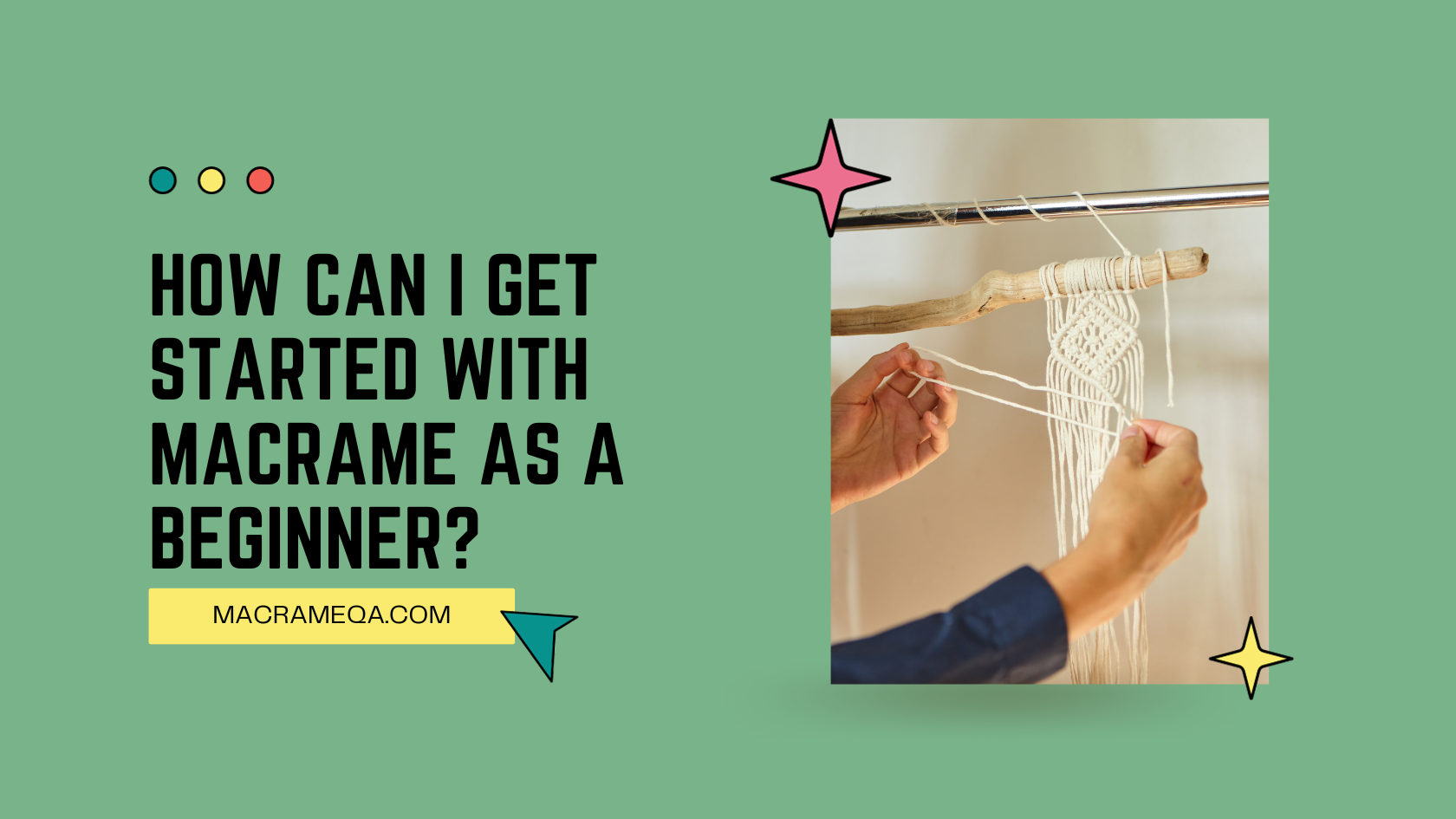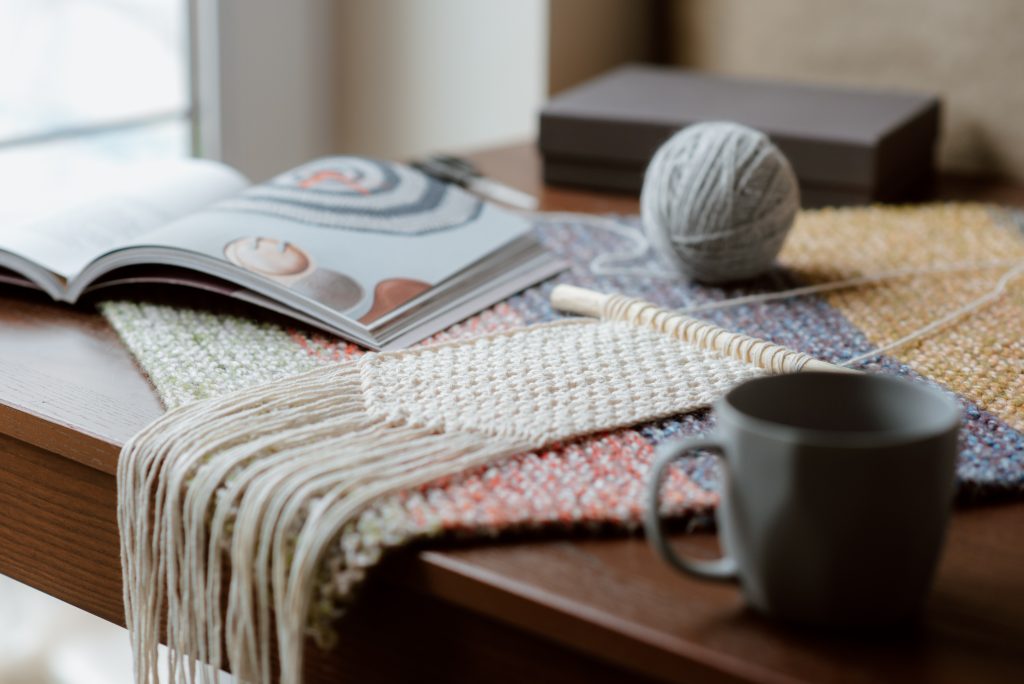Macrame is an amazing craft. Beginners can find their creativity in the intricate knotting techniques. With a mix of accuracy and beauty, Macrame has limitless potential.
Gather the must-haves, like a cord, scissors, and a dowel or hoop. Then it’s time to start knotting! Learn the basics like the square knot, half hitch, and lark’s head knot. When these become easy, you can move on to more complex techniques. Try different combinations to make cool patterns and textures.
For tips, explore online tutorials, books, and magazines. Or join forums and connect with other Macrame fans. The community is very helpful.
Kim is a great example. She was a beginner who found Macrame on social media. She made keychains and wall hangings. With practice, Kim created her own style and started selling her projects.
If you want to start Macrame, just get the materials and master the knots. Seek out inspiration and let your creativity take over. Welcome to the world of Macrame, where the possibilities are endless!
Gathering the Necessary Materials
To successfully gather the necessary materials for your macrame journey, choose the right macrame cord, select the appropriate macrame needles or hooks, and consider additional materials for decorative touches.
Choosing the Right Macrame Cord
Choosing the right macrame cord is key for successful projects. Think about factors like thickness, texture, and durability to find the perfect cord.
I did lots of research and put together a table to help you make an informed decision. Here are different cords with their thickness, texture, and durability ratings:
| Cord Type | Thickness | Texture | Durability |
|---|---|---|---|
| Cotton | 3mm | Soft | High |
| Jute | 5mm | Rough | Medium |
| Nylon | 4mm | Smooth | High |
Cotton cords are popular due to being soft and durable. Whereas jute cords have a rougher texture that adds something special to your projects. Nylon cords have a smooth finish and also have high durability.
Another factor to think about is the color options available. Whether you like natural tones or bright shades, picking a color that fits your design can make it look even better.
To make your decision easier, consider these:
- Check the project needs: Think if your design needs a softer or rougher texture.
- Weight of the project: Thicker cords are good for large pieces while finer cords are better for delicate designs.
- Try different materials: Cotton, jute, or nylon – try them out to see which one works best for your project.
By considering these things and evaluating thickness, texture, and durability, you can select the right macrame cord that fits both your vision and needs. Enjoy knotting!
Selecting the Appropriate Macrame Needles or Hooks
Choosing the right tools for macrame work is essential for successful crafting. Needles and hooks are useful tools that enable intricate designs. There are various sizes and materials, each with its own purpose. Here’s a table of them:
| Size | Material | Purpose |
|---|---|---|
| Small | Steel | Fine details |
| Medium | Wood | Better grip |
| Large | Plastic | Larger projects |
Don’t forget the shape of the needle or hook! Pointed needles are great for precise patterns and blunt ones stop snagging. Custom tools are available for micro-macrame and unusual materials. Seek advice from experienced macrame artists to find the best equipment.
When deciding on your macrame needle or hook, consider your preferences and level of comfort. Experimenting can help you find your ideal fit.
Optional: Additional Materials for Decorative Touches
Want to give your project some extra style? Look into using these optional materials for decoration:
- Ribbon or lace – Add elegance with ribbon or lace.
- Beads or sequins – Make it sparkle with beads or sequins.
- Buttons – Use buttons of various shapes, sizes, and colors for unique textures.
- Fabric scraps – Spice it up with fabric scraps in various patterns and textures.
- Feathers – Give it a whimsical touch with feathers in various shades.
- Glitter or metallic paint – For a glamorous finish, add glitter or metallic paint.
These materials aren’t necessary, but they can take your project up a notch. Ribbons or lace can bring sophistication. Beads or sequins can add sparkle. Buttons offer versatility for designs. Fabric scraps give a creative edge. Feathers can be whimsical. And, glitter or metallic paint makes it shine.
Ancient people added beauty and symbolism to jewelry with precious stones and metals. Now, we have access to a wide range of materials that let us explore endless possibilities.
Learning Basic Macrame Knots and Techniques
To master the foundation of macrame as a beginner, dive into learning basic knots (such as the square knot, half hitch, and lark’s head knot). Once you grasp these fundamentals, practice simple projects that will help you solidify your knotting skills.
Introduction to Basic Knots (Square Knot, Half Hitch, Lark’s Head Knot)
Macrame is the art of creating decorative knots! Three fundamental knots – Square Knot, Half Hitch, and Lark’s Head Knot – are a great place to start.
The Square Knot is two knots tied together, forming a square shape. It’s used often in macrame projects.
The Half Hitch knot is wrapping a cord around an anchor cord and pulling it through. You can repeat this knot to create texture and patterns.
The Lark’s Head Knot is used to attach cords or other materials to a base cord. Fold the cord in half, pass the folded end under a base cord, and pull the ends through the folded loop. This knot creates a secure attachment point.
Beyond these knots, there are variations and combinations to explore. Macrame techniques go back thousands of years to ancient civilizations. It gained popularity in the Victorian era and now there are various styles and applications. From wall hangings to accessories, macrame is captivating with its versatility and intricate beauty.
Grab your cords, practice these basic knots, and open up endless possibilities! Mastering the knots is not for the weak-hearted – but you won’t be disappointed.
Practice Simple Projects to Master Knots
Are you seeking to master macrame? Practicing basic projects is the way to go. Through these projects, you can learn the essential knots and techniques while crafting beautiful pieces. Here’s a guide to help you begin:
- Choose a project. Pick a simple macrame project that requires the knots you want to practice – be it a plant hanger or a wall hanging.
- Gather materials. After choosing your project, collect all the necessary materials, such as rope, scissors, and decorative elements.
- Understand the basics. Before starting your project, get to know the primary macrame knots, like the square knot, half hitch knot, and lark’s head knot. Practice each knot until you’re comfortable with them.
- Start the project. Now that you understand the knots, commence your macrame project! Follow the instructions in the pattern or tutorial, and use the knots to your advantage.
Remember, practice makes perfect! The more projects you complete, the more confident you’ll become in your macrame skills. Feel free to experiment with different cord types and colors for extra flair.
Also, macrame has been around for thousands of years. Its origins can be seen in ancient Babylonian and Assyrian civilizations, where knotting was used for both decorative and practical purposes.
So start knotting and crafting – the possibilities are endless!
Starting Your First Macrame Project
To confidently start your first macrame project, equip yourself with the necessary knowledge. Choose an easy beginner-friendly pattern, accurately measure the macrame cord after preparation, and then diligently follow the step-by-step instructions. These sub-sections will guide you through the process, ensuring a smooth and successful macrame endeavor.
Choosing an Easy Beginner-Friendly Pattern
Finding the right Macrame pattern for your first project can be daunting. Here’s what to consider:
- Try basic knots, like the square knot and half-square knot.
- Choose a design with fewer cords, so you can focus on mastering the technique.
- Look for patterns with clear instructions and visual aids.
- Start with a smaller project, like a plant hanger or wall hanging.
Remember, practice makes perfect. And don’t be afraid to experiment! Try unconventional materials like repurposed fabric strips. Or add beads to your patterns, like my friend did. With creativity and dedication, you’ll soon be crafting stunning pieces. So get ready – macrame is about to have you tied up in knots!
Preparing and Measuring the Macrame Cord
Choose the best cord for your project! Think about thickness, material and color – this will make a big difference in the final outcome. Measure your design with a tape measure or ruler to get accurate measurements. Cut the cord with sharp scissors or shears. To prevent fraying, lightly fuse or tape the ends.
Ready to start crafting? Don’t forget to prepare and measure the macrame cord. It’s a crucial step for a successful project. Take your time and be precise. Let your creativity shine! With the right instruction, macrame will be like a walk in the park.
Following the Step-by-Step Instructions
To finish your macramé project successfully, you must follow the instructions given step-by-step. This helps you reach your goal without confusion or mistakes. Here’s a 4-step guide to help you:
| Step | Description |
|---|---|
| 1 | Read the instructions carefully. Take your time to understand each step. This will help you anticipate any difficulties or questions that may come up. |
| 2 | Gather all materials needed. Having everything ready will save time and keep disruptions away. |
| 3 | Follow each step precisely. Notice details like knot types and measurements to get accuracy. Deviating from the instructions could give a different result. |
| 4 | Seek help if needed. If you’re having trouble, ask an experienced macramé artist or look at online tutorials. Patience and precision are key. |
Moreover, practice makes perfect in mastering macramé techniques. If your first attempt is not perfect, don’t worry—it’s part of learning!
Also, based on Crafting Love Magazine’s research, people who follow the instructions carefully are more satisfied with the final project.
Remember, even the most skilled macramé artists had to start somewhere and made a tangled mess that looked like a cat’s hairball.
Troubleshooting and Common Mistakes
To troubleshoot and avoid common mistakes in macrame as a beginner, focus on identifying and fixing knot errors while also learning how to deal with tangled cords. This will help ensure smooth and error-free progress in your macrame projects.
Identifying and Fixing Knot Errors
Identifying and fixing knot errors is a must! A single mistake can have serious consequences, so it’s essential to do it properly. Here’s a 3-step guide to help you:
- Examine the Knot: Carefully look for crossed or twisted strands, loose ends, or uneven tension. This will give you a clearer understanding of the issue.
- Analyze the Technique: Once you spot the errors, analyze the technique used for creating the knot. Compare each step to the standard procedure. Pay attention to twists, loops, and securing methods.
- Make Adjustments: Untangle crossed strands, straighten twisted sections, and tighten loose ends. Make sure each step is exact, following the standard procedure.
Remember, different knots require their own approaches in identifying and fixing errors. Knowing these intricacies will get you the best results.
Since ancient times, incorrect knot usage has caused disasters. One example is the Carrick bend knot, which was designed to join two heavy ropes on ships. Due to its complexity, sailors often made mistakes under pressure, leading to catastrophic failures.
To keep mishaps from happening, pay attention when dealing with knots. Proper knowledge and correct techniques are the key to successful outcomes.
Dealing with Tangled Cords
Untangling cords can be a hassle, but tackling it is easy with the right tips. Here are five to help you out:
- Start by gently separating the cords to stop knots getting worse.
- For stubborn tangles, try WD-40 or silicone spray.
- Cable clips or Velcro ties will keep cords organized.
- Colour-code cords using electrical tape or labels.
- When not in use, store cords neatly with twist ties or elastic bands.
Stay organized and you’ll be more productive. But why not make it fun? Give yourself a time limit or get a friend to join in.
End the cord chaos today! Back up your code first, though – great power comes with great responsibility.
Progressing to Intermediate-Level Projects
To progress to intermediate-level projects in macrame, dive into more complex knots and patterns, while also experimenting with different cord types and colors. This will broaden your skills and allow you to create intricate and unique designs. Expand your horizons and take your macrame journey to the next level by embracing these techniques.
Exploring More Complex Knots and Patterns
As you advance to intermediate-level projects, you’ll discover the captivating world of complex knots and patterns. Crafting these intricate designs takes skill and focus, allowing you to make truly one-of-a-kind pieces. Mastering these advanced techniques brings your craftsmanship to the next level.
When tackling these complex knots and patterns, it’s essential to pay attention to every detail. Each knot has its own particular technique and complexity that must be mastered for a flawless result. Take your time, follow tutorials or seek guidance if needed. With practice, patience, and effort, you’ll soon be crafting astonishing pieces that display your skills.
Did you know? Knotting has been around for thousands of years, found in numerous cultures all over the world. From ancient decorative uses to practical uses like sailing and fishing – knots have had an immense impact on human history (source).
Cords come in all kinds of shapes, sizes, and colors – just like the fantastic range of unfinished projects you’ll get to… someday.
Experimenting with Different Cord Types and Colors
Let’s take a look at the various cord types and colors available. A table gives us an idea:
| Cord Type | Thickness | Texture | Material Composition | Colors Available |
|---|---|---|---|---|
| Nylon | Thin | Smooth | Synthetic | Black, White, Red |
| Cotton | Medium | Soft | Natural | Beige, Blue, Pink |
| Jute | Thick | Rough | Natural | Brown, Green |
| Satin | Thin | Silky | Synthetic | Purple, Gold |
Each cord type has its own unique characteristics. Nylon gives a sleek look, cotton is soft, jute is rustic, and satin exudes elegance.
It’s time to get creative! Try combining different cords and colors to make eye-catching patterns or color schemes. Who knows? Maybe you’ll discover unexpected pairings that will wow everyone.
Take the example of an artist who used traditional cotton cords but then switched to vibrant satin cords. His pieces became stunning works of art that caught the attention of art lovers around the world.
Experimenting with cords and colors is all about pushing boundaries and exploring new realms of creativity. So go ahead, be daring and explore this exciting journey of artistic exploration!
Tips for Creating Professional-Looking Macrame Pieces
To achieve professional-looking macrame pieces, master proper finishing techniques and add personalized touches and embellishments. These sub-sections in the Tips for Creating Professional-Looking Macrame Pieces will guide you through achieving expert-level results in your macrame projects.
Proper Finishing Techniques
Macrame pieces need proper finishing for that professional look.
Here are key points to remember:
- Secure knots tightly. Add fabric glue or clear nail polish to stop them from unraveling.
- Cut any excess cord length for a neat appearance.
- Bind cords with clear tape or apply fabric glue to prevent fraying.
- Enhance the piece with beads, feathers, or tassels.
- Experiment with different cords for textures.
Don’t forget the details. Wall hangings need evenly-spaced hanging loops. Jewelry needs appropriate clasps and closures.
Macrame has a long history, according to Macrame Magic. Personalize your wall hangings to show off your hobby!
Adding Personalized Touches and Embellishments
To make your macrame pieces look professional, adding personal touches is key. You can use your creativity and style to make them stand out. Here are some tips:
- Color it up: Try out different color combinations to bring life and uniqueness to your piece. Pick shades that show off your personality or match the theme of the space.
- Introduce texture: Use materials such as beads, feathers, or shells to add texture and depth to your design. Little things can make a big difference.
- Charms: Attach charms or pendants that mean something special to you or the recipient. This makes the artwork more meaningful.
- Messages: Use letter beads or embroidery to weave in words or phrases. This adds uniqueness and is a reminder of positive affirmations!
- Include nature: Intertwine elements like dried flowers, leaves, or twigs for a natural feel and element of surprise.
If you want to go further, you can also:
- Wrap threads around sections for more visual interest.
- Interlace ribbons or lace trimmings into patterns for a classy touch.
- Attach trinkets or bells for subtle adornment.
Let your imagination go wild and explore possibilities when it comes to personalizing your macrame pieces. Macrame art began in ancient Babylon and Assyria, so you can make stunning pieces or just have fun with it. These tips will help you make a professional-looking masterpiece!
Conclusion and Next Steps
As a newcomer to macrame, it’s vital to get the hang of the essential steps. After learning the basics, explore further options! Experiment with various materials and colors. Use books, online tutorials or join a local macrame community for inspiration. Immerse yourself in macrame to find unique details.
Grow your skills by attending workshops or classes. Analyze your work and set future goals. Don’t shy away from complex designs or materials. Ask for feedback from fellow enthusiasts. Share your creations on social media.
Practice often to build muscle memory. Don’t get down if things don’t go as planned. Mistakes are a chance to learn and grow creatively.
Frequently Asked Questions
Q: What is macrame?
A: Macrame is a craft that involves creating decorative knots using various materials like yarn, rope, or cord to make items such as wall hangings, plant hangers, and jewelry.
Q: How can I get started with macrame?
A: To get started with macrame, you can begin by learning basic knots such as the square knot and the lark’s head knot. There are many online tutorials and instructional books available that can help you understand the techniques and patterns used in macrame.
Q: What materials do I need to start macrame?
A: As a beginner, you will need some basic materials like macrame cord or rope, scissors, and a dowel or ring to hang your project. You can also experiment with different colors and textures of cords to add variety to your macrame creations.
Q: How do I learn macrame knots?
A: Learning macrame knots is best done through hands-on practice. You can start by watching tutorial videos online or following step-by-step instructions in macrame books. It is important to practice each knot multiple times until you feel comfortable and confident in creating them.
Q: What are some easy macrame projects for beginners?
A: Some easy macrame projects for beginners include making simple plant hangers, keychains, or decorative wall hangings. These projects usually involve basic knots and can be completed in a relatively short amount of time.
Q: Where can I find macrame supplies?
A: Macrame supplies can be found in craft stores, online marketplaces, and specialized macrame supply shops. You can purchase macrame cords, beads, rings, and other accessories from these sources.











